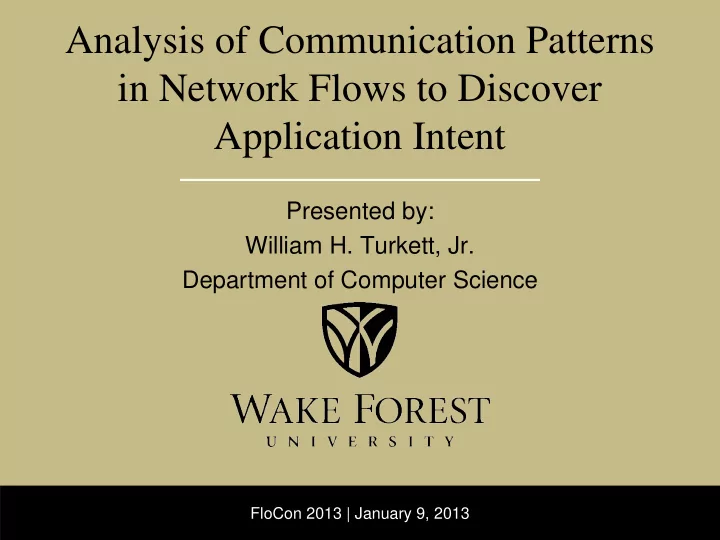

Analysis of Communication Patterns in Network Flows to Discover Application Intent Presented by: William H. Turkett, Jr. Department of Computer Science FloCon 2013 | January 9, 2013
Traditional Traffic Classification Techniques Port- and payload Traditional HTTP connection: signature-based [src, src prt, dst, dst port, payload] classification [10.1.11.58,8754, 10.19.132.45,80, techniques are “GET /index.html”] increasingly less HTTP useful in modern traffic analysis. Modern traffic: Statistical approaches [10.1.11.58,8754, 10.19.132.45, 9090, evaluating features “xZvRmTTlFz”] Alternative such as packet size ports/tunneling and interarrival times Encrypted developed in payloads response.
Graph Based Approaches To Traffic Classification Graph based approaches look at at the broader context of host interactions (interaction networks instead of topological networks) BLINC - Graphlet Graption – Traffic Dispersion Graph Karagiannis et al. - BLINC: Multilevel Traffic Classification In The Dark, SIGCOMM Proceedings, 2005. Iliofotou et al. Graption: Graph-based P2P Traffic Classification At The Internet Backbone, Computer Networks, 2011
Communication Patterns And Motifs Motifs are patterns of interconnections occuring in networks at rates greater than expected by chance. Flow-level statistics can be employed to color graph nodes (hosts), allowing for annotated motifs – Bytes : {Max, Average, Sum} bytes sent by a host over all connections host involved in – Duration : {Max, Average, Sum} duration of connections host involved in – Node Type : Client, server, or peer activity
Communication Patterns And Motifs { 1 0 0 0 1 1 0 0 } Motif profiles for a host represent in a binary vector which annotated motifs a host participates in Tools such as FANMOD can mine graphs for motifs and determine host-level motif participation
Information Available From Flow Data The data of interest to build graphs and color nodes is all accessible from flow data: – Host-host interactions (Src-Dst) – Summary-level statistics of traffic • Number of bytes transferred over connections • Duration of connections (timestamps) – Assume can capture internal-to-internal and internal-to-external connections
A Deeper Problem: Discovery of Application Intent Streaming media Email HTTP Chat Browsing Single network protocols are now commonly employed for a variety of applications (intents)
SSH: Application Intent Terminal File Transfer SSH Tunneling
Essence of Approach Goal is labeling host intent from capture of a window of activity – Potentially multiple connections within a window of activity – Assuming that intents are used in isolation within a session As designed currently, prime application is post- mortem analysis of host activity of interest. Premise of research: – Annotated and directed motifs capture significant information about communications – Hypothesis: Distinct motif usage suggests distinct intent.
Traffic Classification Using Motifs: Initial Work Our original work in this area (2009) explored separability of individual protocols, not intents. Modeling approach consisted of: – Construction of interactions graphs for each protocol – Node coloring by host type (client/server/peer) – Host motif profiles were over sets of size three or size four motifs from interaction graphs Host-protocol classification approach consisted of: – Weighted-feature one-nearest-neighbor
Protocol Separation Using Motifs
Data Sets For Intent Analysis Goal is labeling host intent from capture of a window of activity Properties of publicly available network datasets lead to difficulty in defining gold-standard datasets for training and analysis Privacy issues lead to IP shuffling and payload removal Intent labeling is even harder
Experimental Design: Flow Capture Traffic Type Source For this work, flows were: Streaming media Youtube – Collected in-house Email GMail – Intents captured in isolation Chat GChat – Captures automated Browsing Yahoo random through AutoIt scripts link generator – Kept any flows involved in a connection to purported HTTP host (port 80, 8080, 443)
Experimental Design: Histograms Of Annotation Statistics No clear separation of distributions over bytes transferred or connection duration from visualization of flow statistics. Average Bytes Transferred Average Flow Duration (Binned, From Flow Statistics) (Binned, From Flow Statistics)
Experimental Design: SVM Approach and Results Summary Support vector machine learning: – Multiple “one-vs.-all” support vector machine models – Max over model scores – 10-fold cross validation Accuracy across flow types (for small sample): Truth Total Node Node Bytes Node Flows Type Only + Type Duration + Type Gchat 21 0.71 1.00 1.00 Gmail 19 0.00 0.68 1.00 Browsing 71 1.00 0.97 1.00 Youtube 46 0.00 0.93 0.94
Node Duration & Type Results Confusion matrix for model with best results – the model employing Node Duration and Type: Label Gchat Gmail Browsing Youtube Truth Gchat 21 0 0 0 Gmail 0 19 0 0 Browsing 0 0 71 0 Youtube 3 0 0 43
Conclusions Building evidence that subgraphs (motifs) of host interaction networks are related to type of activity (intent) being performed by hosts Flow metrics, traditionally employed by statistical approaches to traffic analysis, can be embedded into graph structures through node coloring
Technology Transfer & Future Work Online costs of deployment for approach: – Building the host interaction network from network monitoring over time – Determination of whether a host is involved in a set of motifs of interest – Classification model scoring Next steps: – Refine traffic generation and collection processes – Determine lower-limit on data required to accurately reflect a host’s activity – Remove assumption that intents are performed in isolation within a session of activity – Understand the important motif structures
Acknowledgements Network Security Colleagues at Wake Forest University Brad McDanel Lee Bailey Tim Thomas Dr. Errin Fulp National Science Foundation Grant # CNS-1018191
Recommend
More recommend